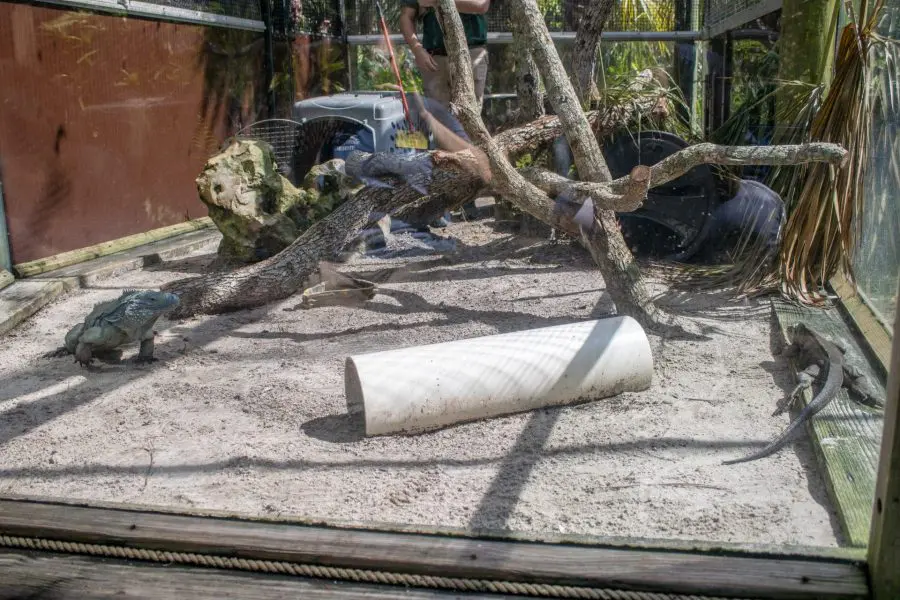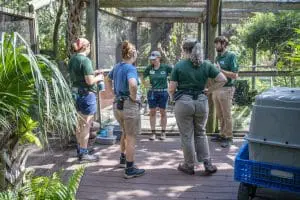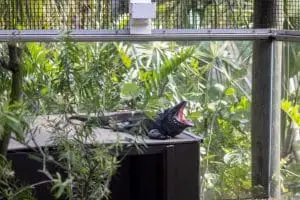

We’ve completed our first set of introductions between our male and female Grand Cayman blue iguanas, Leonard and Lucia!
Pairing this duo together is important for the species as a whole. Grand Cayman blue iguanas are classified as endangered – as recently as 2001 they were listed as critically endangered with less than 30 iguanas in their natural range. Thanks to conservation breeding programs in the Cayman Islands and beyond, this species is making a comeback. These iguanas are included in the Associations of Zoos and Aquariums’ (AZA) Species Survival Plan (SSP).
“The genetics of the population are tracked, and breeding recommendations are made across participating zoos so that the species population has the best opportunity of growing and thriving in the most healthy way,” Nicole Payne, the area supervisor of our Herps & Aquatics team said of SSPs.

Meet Lucia, our female Grand Cayman blue iguana!
The SSP recommended that 10-year-old Leonard and 5-year-old Lucia be paired. Our animal care team has been waiting to introduce them until Lucia reached maturity, which she just reached this season.
Introducing animals is always a careful process! Grand Cayman blue iguanas are particularly territorial, both males and females, so it would be unlikely to see mature adults spending time near each other throughout the year. When breeding season starts in late spring or early summer, males and females become more receptive to each other and will seek out mates for brief breeding encounters before separating again.
Introductions took place in several phases, starting with moving Lucia to the habitat next to Leonard’s. These two habitats share a clear wall, so they’re able to see each other. Then the animal care team started a “howdy” phase where Leonard was brought into Lucia’s space but remained in a secure carrier so the two could see and smell each other without physical contact. During this howdy phase, at least one keeper stayed with them to monitor the interaction and assess their level of interest in each other.
“We keep detailed notes of the behavior of both individuals so we can track progress between sessions and plan our next steps,” Nicole said.
 Next – you probably guessed it – were the full-contact introductions. The entire Herps & Aquatics team is on hand during these sessions: a keeper and an animal curator remain in the habitat with Leonard and Lucia, another keeper is on standby just outside the habitat in case more help is needed, and another keeper records all details of the introduction and is available as needed. Our veterinary staff is also made aware of the introductions that are taking place. Did we mention this species is a bit territorial?
Next – you probably guessed it – were the full-contact introductions. The entire Herps & Aquatics team is on hand during these sessions: a keeper and an animal curator remain in the habitat with Leonard and Lucia, another keeper is on standby just outside the habitat in case more help is needed, and another keeper records all details of the introduction and is available as needed. Our veterinary staff is also made aware of the introductions that are taking place. Did we mention this species is a bit territorial?
“The habitat is set up in a way that provides visual barriers as well as “hides” if Lucia decides she needs to duck away to evade or avoid Leonard (or vice versa!),” Nicole said. “We prepare so the iguanas can respond naturally to their breeding interest or disinterest, while being able to step in if needed.”
Iguana breeding in general is fairly “rough”, Nicole said, as the male will chase the female to pin and hold her in place for copulation to occur. Knowing what behaviors are appropriate comes from a lot of research and being familiar with the species, she added. Other SSP participants share information and knowledge with each other so we can all succeed together to protect the species. This particular species of iguana has lots of scales and extra loose skin to enable wiggling and twisting under the restraint of another without incurring a major injury.

Leonard, our Grand Cayman blue iguana, says hi!
“If the bites are intentionally directed toward other areas, such as toes or feet, the chasing lasts longer than normal, the behavior becomes more aggressive than breeding-intended, one of the individuals is clearly not receptive (shows only avoidance behaviors, is becoming overly stressed), or a more serious wound occurs, we would intervene,” Nicole said.
This is Lucia’s first reproductive season, and copulation hasn’t occurred quite yet. We have not yet seen Lucia digging a nest, though we have provided her with several nesting material options and locations. It is possible she may reabsorb the egg follicles rather than further developing and depositing eggs.
“Either outcome is possible, so we continue to offer the appropriate space and monitor her behavior,” Nicole said.
If she does lay eggs, they would be incubated by the Herps & Aquatics team to ensure they have the ideal conditions to develop properly and increase the chances of their hatching. Since our iguanas live outdoors, we are unable to regulate those conditions in the habitat with the constantly changing weather, torrential downpours, and heat that our Florida summer provides.
Although female iguanas may guard a nest some, the hatchlings are precocious and do not receive any parental care; this means there are no concerns about facilitating parent rearing or attempting to mimic their actions as we hand raise. Any hatchlings would be provided appropriate habitats in which to grow on their own, just like they would in their native range!
While this breeding season is over, we’ll continue keeping you updated on how Leonard and Lucia do next year! You can spot them in our Caribbean Trail, which is located just before our Rainforest Revealed loop.
Brevard Zoo is an independent, not-for-profit organization that receives no recurring government funding for our operating costs. Your generous support enables us to continue to serve our community and continue our vital animal wellness, education and conservation programs.
